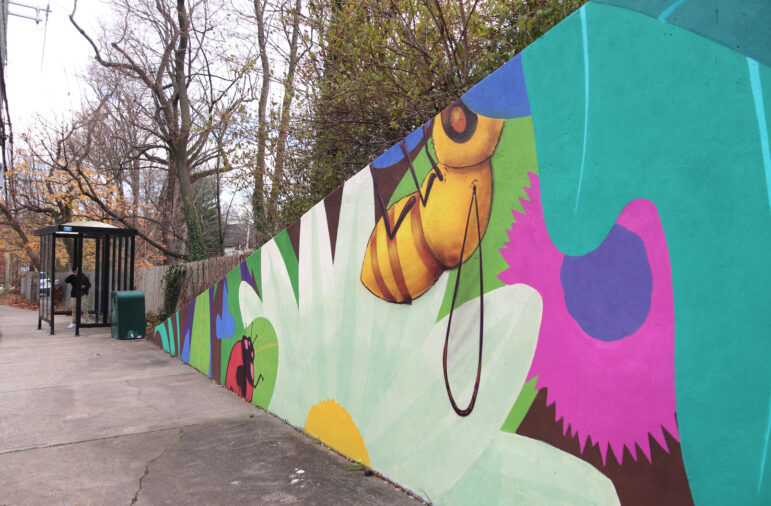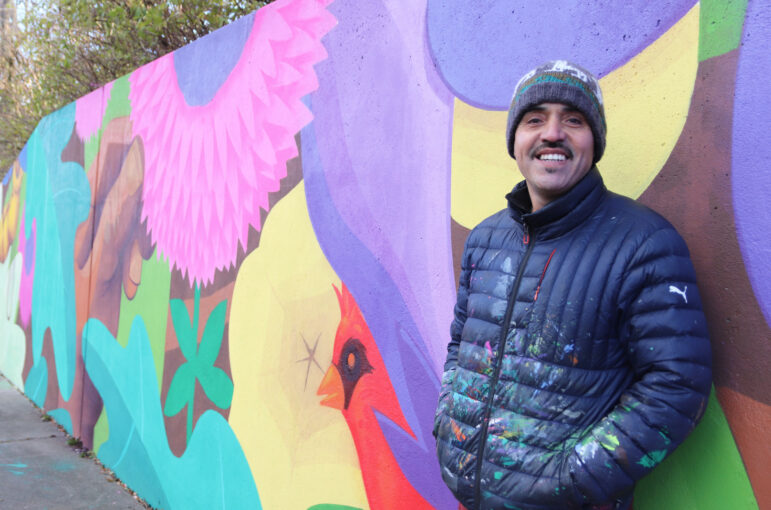On Monday, with a film crew in tow, muralist Nelson Rivas and his team put the finishing touches on the cheerful pollinator mural by the East Putnam Ave bus stop across from Greenwich High School.
The mural, which depicts native pollinator-friendly habitats and food sources for bees, birds, butterflies, and other pollinating insects and wildlife, got off to a rocky start last May when a stop work order was issued.
It took several months for the project to get the blessing of the full RTM, who approves gifts to the town. Skeptics were concerned that future murals might be political in nature or that they might proliferate across town.

Pat Sesto, Greenwich’s Director of Environmental Affairs, spoke in favor of the mural both for its educational value, and de facto role as “a big time selfie wall,” and ultimately, in September, the RTM voted 121 in favor of the mural, 68 opposed, with 5 abstentions.
Since then Mr. Rivas has worked to complete the mural before winter weather sets in.
By Monday afternoon the painting was complete, though it awaits its anti-graffiti coating. Also, the bus shelter needs to be moved back in place and educational panels installed inside.
Mr. Rivas said he was thrilled to see the finished mural.
“The message is crucial,” he said. “The mural raises awareness of the importance of pollination. If plants cannot reproduce then we die in a slow way. Pollination is part of the cycle of life.”
“Besides the mural’s message, it will encourage other artists to start painting,” he said. “At the end of the day, when you do a public art piece, it’s about sharing. It’s not in a gallery or a home, but in the public realm for everyone to see.”
Mr. Rivas said he developed his skills as a muralist growing up in Santiago, Chile when he was growing up. “It was hands on learning – I learned by doing.”
He said a part of his experience as a muralist was interacting with the public. His murals evolved from graffiti and faces of people to nature based designs.
“Every time you paint outside someone is going to come and ask you questions, or give you their opinion. Some of the time, they don’t like it. It’s subjective,” he continued. “The GHS teenagers have said they like the mural. Some ask if they can help paint.”
The Cardinal, which was added to the mural on Monday, was well received.
“I like it,” said GHS junior Claudio Baldiviezo who was waiting for the bus.

As Mr. Rivas painted, Sustainability Committee member Myra Klockenbrink, who championed the mural project for months, was busy at the east end of the wall planting a perennial shade garden which will make its show in the spring.
She explained that the bus shelter will become something of a mini museum, with panels featuring information on the pollinator pathway and native plants.
“If the gods are on our side, the area will be in bloom,” Klockenbrink said, adding that there are about 30 different species and 250 different plants.
While the Forsythia that cascades over the top of the mural in April was left in place, they the Burning Bush on the east end of the wall has been replaced with Sweetspire, Witch Hazel, Rhododenrons, Hydrangeas and Heucheras (Coral Bells).
“This is a mural, but it’s really a mural project. It’s an entire installation – with the garden, the bus shelter museum, the mural, and a film that documents what we’ve done,” Klockenbrink said, adding that Ms Sesto’s prediction was also on the mark.
“People have been coming to take selfies all day,” she added.
Klockenbrink said when complete, the film will be on the Sustainability Committee’s web page on the town website.









